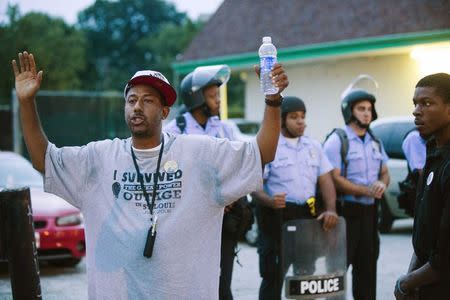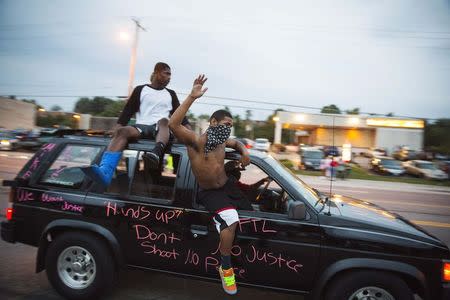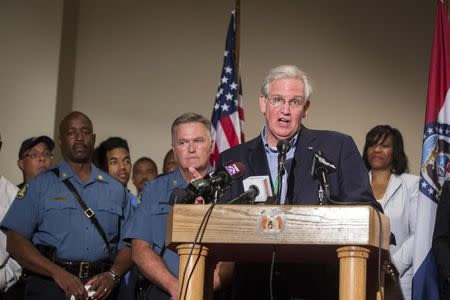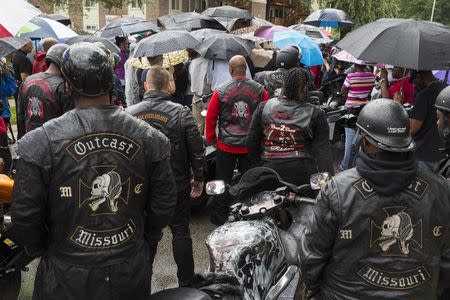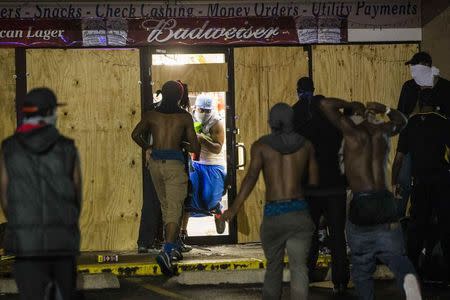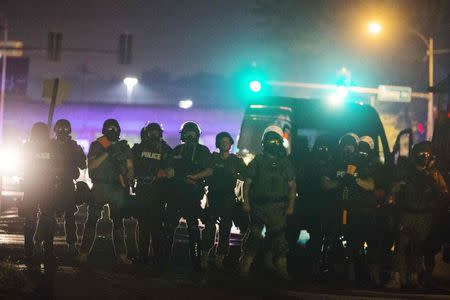Protesters take to streets again ahead of curfew in Ferguson
By Ellen Wulfhorst FERGUSON Mo. (Reuters) - Hundreds of demonstrators in Ferguson, Missouri, angry at the shooting death of a black teenager by police took to the streets in the rain on Saturday night, hours ahead of a planned curfew called for by the state's governor. Missouri Governor Jay Nixon has declared a state of emergency, as he and other officials seek to restore order after a week of racially charged protests and looting over the shooting of an unarmed black teenager by a white police officer. The curfew will run midnight until 5 a.m. CDT (0500 to 1000 GMT) until further notice, said Highway Patrol Captain Ron Johnson. Johnson was named by the governor this week to oversee security in the suburban St. Louis community that has been roiled by the Aug. 9 shooting of 18-year-old Michael Brown. The mood among hundreds of protesters on a main road in Ferguson that has been the scene of recent demonstrations was tense and defiant on Saturday night, in marked contrast to the festive atmosphere of Thursday. Scores of police in bullet-proof vests lined the sides of the road in the rain. "I'm a grown man, 24 years old," said demonstrator Phonso Scott. "I can be out here as long as I want to be. I'll be right here at 12:01, 12:02." "The curfew is going to make things worse," he said. "I think the cops are going to get violent tonight, but they can't lock us all up." Earlier in the day, Nixon and other officials came face to face with angry members of the community during a tense news conference at a church near Ferguson. "The eyes of the world are watching. This is the test of whether a community, this community, any community, can break the cycle of fear, distrust and violence, and replace them with peace, strength and, ultimately, justice," Nixon, a Democrat, told the gathering. Some in the crowd reacted angrily to the news and several said the police officer who killed Brown must be prosecuted for murder if peace is to return to the community. But Nixon said public safety had to be protected. "We cannot have looting and crimes at night. We can’t have people fearful,” he said. The unrest erupted after police officer Darren Wilson, 28, shot and killed Brown shortly after noon a week ago as Brown and a friend walked down a street that runs through an apartment complex where Brown's grandmother lives. Tensions have been high all week but escalated on Friday evening as protesters again swarmed through a residential and retail district that has become a center of the unrest, pitting mostly black protesters against mostly white police. On Saturday, people marching through city streets held signs that read "Black lives matter," and "Don't shoot." Brown's family and supporters have demanded for days that the officer who shot Brown be held accountable. The U.S. Department of Justice is investigating the shooting for any civil rights violations, and the St. Louis County Police department is also investigating the shooting. ROBBERY ACCOUNT FUELED PROTESTS For days, police repeatedly refused to identify the officer involved, citing concerns for his safety. On Friday, Ferguson Police Chief Tom Jackson gave in to community pressure and identified Wilson as the officer involved. But at the same time, Jackson added to the community's outrage when he announced Brown had been a suspect in a robbery of a convenience store at the time he was shot. Jackson later told a news conference that when Wilson shot Brown, the officer did not know the teen was a suspect in the robbery. There was no connection between the shooting and the alleged robbery, Jackson said. Attorney Ben Crump, who is representing Brown's family, said in a statement issued on Friday that the family was "beyond outraged" at the police attempts to "assassinate the character of their son." Civil rights activist the Reverend Al Sharpton said he would lead a rally with Brown's family in Ferguson on Sunday. Other law enforcement agencies have criticized the Ferguson police department for trying to make the alleged robbery an issue connected to the shooting, and for releasing a video from inside the store that shows Brown violently shoving a store clerk before he walks out the door. The U.S. Justice Department asked Ferguson police on Thursday not to release the video, out of a concern it would roil the community further, but on Friday it was released over the objections of federal officials, said a law enforcement official speaking on condition of anonymity. CONFUSION OVER KILLING The police version of Brown's shooting differs markedly from witness accounts, including that of the friend who was walking with Brown at the time, Dorian Johnson, 22. In the police version, after Wilson asked Brown to move out of the road onto a sidewalk, Brown reached into the patrol car and struggled with Wilson for the officer's service gun. Wilson, who sustained a facial injury, then shot Brown a number of times. Johnson and at least one other witness have said the officer reached out through his car window to grab at Brown and the teenager was trying to get away from the officer when he was shot. Brown held up his hands in a sign of surrender but the officer got out of his patrol car and shot Brown several times, they said. Brown family attorney Anthony Gray said on Saturday that Dr. Michael Baden, a high-profile forensic pathologist, will conduct a second autopsy on Brown's body, according to CNN. FBI agents were at the scene of the shooting on Saturday interviewing residents, and civil rights activist Jesse Jackson also visited the site, leading a prayer near a makeshift memorial to Brown just a few feet from where he died. (Additional reporting by Jason McLure in St. Louis, Carey Gillam in Kansas City, Jonathan Allen, in New York, Lucas Jackson in Ferguson, Missouri, and Alex Dobuzinskis in Los Angeles; Writing by Carey Gillam; Editing by Marguerita Choy, Eric Walsh, Frances Kerry and Lisa Shumaker)
